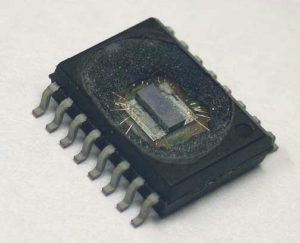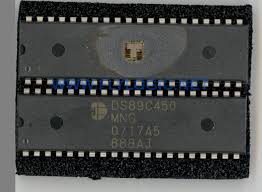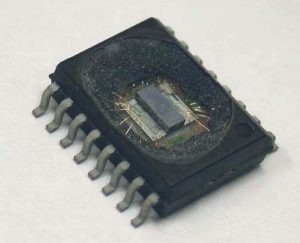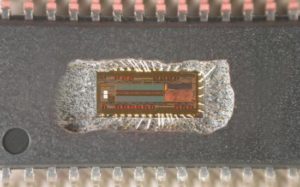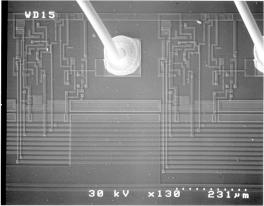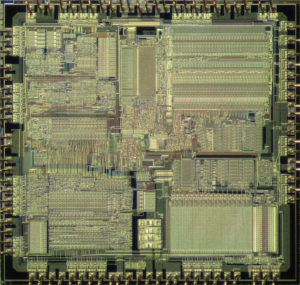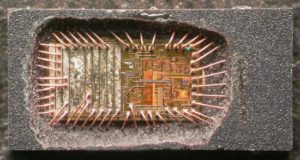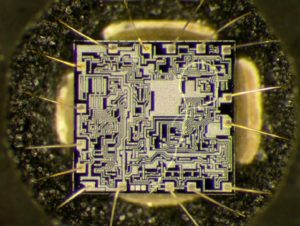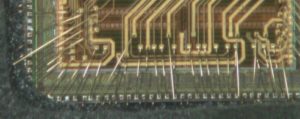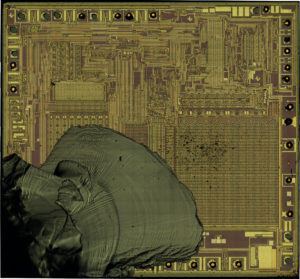Archive for the ‘Recover MCU’ Category
 Attack Chip PIC16C622A Software
Attack Chip PIC16C622A Software
The high performance of the PIC16C62X family can be attributed to a number of architectural features commonly found in RISC microprocessors which is critical feature for Attack Chip PIC16C622A Software. To begin with, the PIC16C62X uses a Harvard architecture, in which, program and data are accessed from separate memories using separate busses. This improves bandwidth over traditional von Neumann architecture where program and data are fetched from the same memory. Separating program and data memory further allows instructions to be sized differently than 8-bit wide data word. Instruction opcodes are 14-bits wide making it possible to have all single word instructions.
A 14-bit wide program memory access bus fetches a 14-bit instruction in a single cycle. A two-stage pipeline overlaps fetch and execution of instructions.
Consequently, all instructions (35) execute in a single-cycle (200 ns @ 20 MHz) except for program branches. The PIC16C620A and PIC16CR620A address 512 x 14 on-chip program memory. The PIC16C621(A) addresses 1K x 14 program memory. The PIC16C622(A) addresses 2K x 14 program memory. All program memory is internal.
The PIC16C62X can directly or indirectly address its register files or data memory. All special function registers including the program counter are mapped in the data memory. The PIC16C62X have an orthogonal (symmetrical) instruction set that makes it possible to carry out any operation on any register using any addressing mode in order to Attack Chip PIC16C622A Software. This symmetrical nature and lack of ‘special optimal situations’ make programming with the PIC16C62X simple yet efficient. In addition, the learning curve is reduced significantly.
The PIC16C62X devices contain an 8-bit ALU and working register. The ALU is a general purpose arithmetic unit. It performs arithmetic and Boolean functions between data in the working register and any register file.
The ALU is 8-bit wide and capable of addition, subtraction, shift and logical operations. Unless otherwise mentioned, arithmetic operations are two’s complement in nature. In two-operand instructions, typically one operand is the working register (W register). The other operand is a file register or an immediate constant when Unlock Microcontroller. In single operand instructions, the operand is either the W register or a file register.
The W register is an 8-bit working register used for ALU operations. It is not an addressable register.
Depending on the instruction executed, the ALU may affect the values of the Carry (C), Digit Carry (DC), and Zero (Z) bits in the STATUS register. The C and DC bits operate as a Borrow and Digit Borrow out bit, respectively, bit in subtraction. See the SUBLW and SUBWF instructions for examples.
 Attack Microcontroller PIC16C710 Program
Attack Microcontroller PIC16C710 Program
We can Attack Microcontroller PIC16C710 Program, please view the Microcontroller PIC16C710 features for your reference:
PIC16C71X Microcontroller Core Features:
· High-performance RISC CPU
· Only 35 single word instructions to learn
· All single cycle instructions except for program branches which are two cycle
· Operating speed: DC – 20 MHz clock input DC – 200 ns instruction cycle
· Up to 2K x 14 words of Program Memory, up to 128 x 8 bytes of Data Memory (RAM)
· Interrupt capability
· Eight level deep hardware stack
· Direct, indirect, and relative addressing modes
· Power-on Reset (POR)
· Power-up Timer (PWRT) and Oscillator Start-up Timer (OST)
· Watchdog Timer (WDT) with its own on-chip RC oscillator for reliable operation;
· Programmable code-protection
· Power saving SLEEP mode
· Selectable oscillator options
· Low-power, high-speed CMOS EPROM technology
· Fully static design
· Wide operating voltage range: 2.5V to 6.0V
· High Sink/Source Current 25/25 mA
· Commercial, Industrial and Extended temperature ranges
· Program Memory Parity Error Checking Circuitry
with Parity Error Reset (PER) (PIC16C715)
· Low-power consumption:
– < 2 mA @ 5V, 4 MHz
– 15 µA typical @ 3V, 32 kHz
– < 1 µA typical standby current
 Attack MCU PIC16F711 Heximal
Attack MCU PIC16F711 Heximal
The PIC16C71X family has special features to reduce external components, thus reducing cost, enhancing system reliability and reducing power consumption which is critical for Attack MCU PIC16F711 Heximal.
There are four oscillator options, of which the single pin RC oscillator provides a low-cost solution, the LP oscillator minimizes power consumption, XT is a standard crystal, and the HS is for High Speed crystals. The SLEEP (power-down) feature provides a power saving mode. The user can wake up the MCU from SLEEP through several external and internal interrupts and resets.
A highly reliable Watchdog Timer with its own on-MCU RC oscillator provides protection against software lock up. A UV erasable CERDIP packaged version is ideal for code development while the cost-effective One-Time-Programmable (OTP) version is suitable for production in any volume.
The PIC16C71X family fits perfectly in applications ranging from security and remote sensors to appliance control and automotive which is the reason for its MCU cracking. The EPROM technology makes customization of application programs (transmitter codes, motor speeds, receiver frequencies, etc.) extremely fast and convenient.
The small footprint packages make this microcontroller series perfect for all applications with space limitations. Low cost, low power, high performance, ease of use and I/O flexibility make the PIC16C71X very versatile even in areas where no microcontroller use has been considered before Attack MCU PIC16F711 Heximal (e.g. timer functions, serial communication, capture and compare, PWM functions and coprocessor applications).
Users familiar with the PIC16C5X microcontroller family will realize that this is an enhanced version of the PIC16C5X architecture. Please refer to Appendix A for a detailed list of enhancements. Code written for the PIC16C5X can be easily ported to the PIC16CXX family of devices.
 Attack IC PIC12F510 Program
Attack IC PIC12F510 Program
We can Attack IC PIC12F510 Program, please view the IC PIC12F510 features for your reference:
High-Performance RISC CPU:
· Only 33 single-word instructions to learn
· All single-cycle instructions except for program branches, which are two-cycle
· 12-bit wide instructions
· 2-level deep hardware stack
· Direct, Indirect and Relative Addressing modes for data and instructions
· 8-bit wide data path
· 10 Special Function Hardware registers (PIC12F510)
· 13 Special Function Hardware registers (PIC16F506)
· Operating speed:
– DC – 8 MHz Crystal Oscillator (PIC12F510)
– DC – 500 ns instruction cycle (PIC12F510)
– DC – 20 MHz Crystal Oscillator (PIC16F506)
– DC – 200 ns instruction cycle (PIC16F506)
Special Microcontroller Features:
· 4 or 8 MHz selectable precision internal oscillator
– Factory calibrated to ±1%
· In-Circuit Serial Programming™ (ICSP™)
· In-Circuit Debugging (ICD) support
· Power-on Reset (POR)
· Device Reset Timer (DRT):
– Short DRT (1.125 ms, typical) for INTOSC, EXTRC and EC
– DRT (18 ms, typical) for HS, XT and LP
· Watchdog Timer (WDT) with dedicated on-chip RC oscillator for reliable operation
· Programmable code protection
· Multiplexed MCLR input pin
· Selectable internal weak pull-ups on I/O pins
· Power-Saving Sleep mode
· Wake-up from Sleep on pin change
· Wake-up from Sleep on comparator change
· Selectable oscillator options:
– INTOSC: 4/8 MHz precision Internal oscillator
– EXTRC: External low-cost RC oscillator
– XT: Standard crystal/resonator
– LP: Power-saving, low-frequency crystal
– HS: High-speed crystal/resonator (PIC16F506 only)
– EC: High-speed external clock input (PIC16F506 only)
· Analog-to-Digital (A/D) Converter:
– 8-bit resolution
– 4-input channels (1 channel is dedicated to conversion of the internal 0.6V absolute voltage reference)
· High current sink/source for direct LED drive
· 8-bit real-time clock/counter (TMR0) with 8-bit programmable prescaler
Low-Power Features/CMOS Technology:
· Operating Current:
– < 170 ìA @ 2V, 4 MHz
· Standby Current:
– 100 nA @ 2V, typical
· Low-power, high-speed Flash technology:
– 100,000 cycle Flash endurance
– > 40-year retention
· Fully static design
· Wide operating voltage range: 2.0V to 5.5V
· Wide temperature range:
– Industrial: -40°C to +85°C
– Extended: -40°C to +125°C
Peripheral Features (PIC12F510):
· 6 I/O pins:
– 5 I/O pins with individual direction control
– 1 input only pin
· 1 Analog Comparator with absolute reference
Peripheral Features (PIC16F506):
· 12 I/O pins:
– 11 I/O pins with individual direction control
– 1 input only pin
· 2 Analog Comparators with absolute reference and programmable reference .
8-bit resolution
– 4-input channels (1 channel is dedicated to conversion of the internal 0.6V absolute voltage reference)
· High current sink/source for direct LED drive
· 8-bit real-time clock/counter (TMR0) with 8-bit programmable prescaler
Low-Power Features/CMOS Technology:
· Operating Current:
– < 170 ìA @ 2V, 4 MHz
· Standby Current:
– 100 nA @ 2V, typical
· Low-power, high-speed Flash technology:
– 100,000 cycle Flash endurance
– > 40-year retention
· Fully static design
· Wide operating voltage range: 2.0V to 5.5V
· Wide temperature range:
– Industrial: -40°C to +85°C
– Extended: -40°C to +125°C
 Attack IC PIC16F54 Eeprom
Attack IC PIC16F54 Eeprom
We can attack IC PIC16F54 Eeprom, please view the IC PIC16F54 features for your reference:
High-Performance RISC CPU:
· Only 33 single-word instructions to learn
· All instructions are single cycle except for program branches which are two-cycle
· Two-level deep hardware stack
· Direct, Indirect and Relative Addressing modes for data and instructions
· Operating speed:
– DC – 20 MHz clock speed
– DC – 200 ns instruction cycle time
· On-ic Flash program memory:
– 512 x 12 on PIC16F54
– 2048 x 12 on PIC16F57
– 2048 x 12 on PIC16F59
· General Purpose Registers (SRAM)
– 25 x 8 on PIC16F54
– 72 x 8 on PIC16F57
– 134 x 8 on PIC16F59
Special Microcontroller Features:
· Power-on Reset (POR)
· Device Reset Timer (DRT)
· Watchdog Timer (WDT) with its own on-ic RC oscillator for reliable operation
· Programmable Code Protection to prevent Microcontroller unlocking
· Power-Saving Sleep mode
· In-Circuit Serial Programming™ (ICSP™)
· Selectable oscillator options:
– RC: Low-cost RC oscillator
– XT: Standard crystal/resonator
– HS: High-speed crystal/resonator
– LP: Power-saving, low-frequency crystal
· Packages:
– 18-pin PDIP and SOIC for PIC16F54
– 20-pin SSOP for PIC16F54
– 28-pin PDIP, SOIC and SSOP for PIC16F57
– 40-pin PDIP for PIC16F59
– 44-pin TQFP for PIC16F59
Low-Power Features:
· Operating Current:
– 170 ìA @ 2V, 4 MHz, typical
– 15 ìA @ 2V, 32 kHz, typical
· Standby Current:
– 500 nA @ 2V, typical
Peripheral Features:
· 12/20/32 I/O pins:
– Individual direction control
– High current source/sink
· 8-bit real-time clock/counter (TMR0) with 8-bit programmable prescaler
CMOS Technology:
· Wide operating voltage range:
– Industrial: 2.0V to 5.5V
– Extended: 2.0V to 5.5V
· Wide temperature range:
– Industrial: -40°C to 85°C
– Extended: -40°C to 125°C
· High-endurance Flash:
– 100K write/erase cycles
– > 40-year retention
 Attack Chip DSP TMS320LF2406APZAR Flash
Attack Chip DSP TMS320LF2406APZAR Flash
We can Attack Chip DSP TMS320LF2406APZAR Flash, below is the Chip DSP TMS320LF2406APZAR features for your reference:
High-Performance Static CMOS Technology
− 25-ns Instruction Cycle Time (40 MHz)
− 40-MIPS Performance
− Low-Power 3.3-V Design
D Based on TMS320C2xx DSP CPU Core
− Code-Compatible With F243/F241/C242
− Instruction Set and Module Compatible With F240 D Flash (LF) and ROM (LC) Device Options
− LF240xA: LF2407A, LF2406A, LF2403A, LF2402A
− LC240xA: LC2406A, LC2404A, LC2403A, LC2402A D On-Chip Memory
− Up to 32K Words x 16 Bits of Flash EEPROM (4 Sectors) or ROM
− Programmable “Code-Security” Feature for the On-Chip Flash/ROM
− Up to 2.5K Words x 16 Bits of Data/Program RAM
− 544 Words of Dual-Access RAM
− Up to 2K Words of Single-Access RAM D Boot ROM (LF240xA Devices)
− SCI/SPI Bootloader D Up to Two Event-Manager (EV) Modules (EVA and EVB), Each Includes:
− Two 16-Bit General-Purpose Timers
− Eight 16-Bit Pulse-Width Modulation (PWM) Channels Which Enable:
− Three-Phase Inverter Control can be used for MCU Cracking
− Center- or Edge-Alignment of PWM Channels
− Emergency PWM Channel Shutdown With External PDPINTx Pin
− Programmable Deadband (Deadtime) Prevents Shoot-Through Faults
− Three Capture Units for Time-Stamping of External Events
− Input Qualifier for Select Pins
− On-Chip Position Encoder Interface Circuitry
− Synchronized A-to-D Conversion
− Designed for AC Induction, BLDC, Switched Reluctance, and Stepper Motor
Control
− Applicable for Multiple Motor and/or Converter Control
D External Memory Interface (LF2407A)
− 192K Words x 16 Bits of Total Memory:
64K Program, 64K Data, 64K I/O
D Watchdog (WD) Timer Module
D 10-Bit Analog-to-Digital Converter (ADC)
− 8 or 16 Multiplexed Input Channels
− 500-ns MIN Conversion Time
− Selectable Twin 8-State Sequencers
Triggered by Two Event Managers
D Controller Area Network (CAN) 2.0B Module
(LF2407A, 2406A, 2403A)
D Serial Communications Interface (SCI)
D 16-Bit Serial Peripheral Interface (SPI) (LF2407A, 2406A, LC2404A, 2403A)
D Phase-Locked-Loop (PLL)-Based Clock
Generation
D Up to 40 Individually Programmable, Multiplexed General-Purpose Input / Output (GPIO) Pins
D Up to Five External Interrupts (Power Drive Protection, Reset, Two Maskable Interrupts)
D Power Management:
− Three Power-Down Modes
− Ability to Power Down Each Peripheral Independently
D Real-Time JTAG-Compliant Scan-Based Emulation, IEEE Standard 1149.1† (JTAG)
D Development Tools Include:
− Texas Instruments (TI) ANSI C Compiler, Assembler/ Linker, and Code Composer Studio Debugger
− Evaluation Modules
− Scan-Based Self-Emulation (XDS510)
− Broad Third-Party Digital Motor Control Support
D Package Options
− 144-Pin LQFP PGE (LF2407A)
− 100-Pin LQFP PZ (2406A, LC2404A)
− 64-Pin TQFP PAG (LF2403A, LC2403A, LC2402A)
− 64-Pin QFP PG (2402A) D Extended Temperature Options (A and S)
− A: − 40°C to 85°C
− S: − 40°C to 125°C
 Attack Microcontroller TMS320C32PCM40 Firmware
Attack Microcontroller TMS320C32PCM40 Firmware
We can Attack Microcontroller TMS320C32PCM40 Firmware, please view below Microcontroller TMS320C32PCM40 features for your reference:
High-Performance Floating-Point DSP
– TMS320C32-60 (5 V)
33-ns Instruction Cycle Time
330 Million Operations Per Second (MOPS), 60 Million Floating-Point Operations Per Second (MFLOPS), 30 Million Instructions Per Second (MIPS)
– TMS320C32-50 (5 V)
40-ns Instruction Cycle Time
275 MOPS, 50 MFLOPS, 25 MIPS
– TMS320C32-40 (5 V)
50-ns Instruction Cycle Time 220 MOPS, 40 MFLOPS, 20 MIPS
32-Bit High-Performance CPU
16- / 32-Bit Integer and 32- / 40-Bit
Floating-Point Operations
32-Bit Instruction Word, 24-Bit Addresses
Two 256 × 32-Bit Single-Cycle, Dual-Access
On-Chip RAM Blocks
Flexible Boot-Program Loader to Unlocking Microcontroller
On-Chip Memory-Mapped Peripherals:
– One Serial Port
– Two 32-Bit Timers
– Two-Channel Direct Memory Access (DMA) Coprocessor With Configurable Priorities
Enhanced External Memory Interface That Supports 8- / 16- / 32-Bit-Wide External RAM for Data Access and Program Execution From 16- / 32-Bit-Wide External RAM
TMS320C30 and TMS320C31 Object Code Compatible Fabricated using 0.7 µm Enhanced Performance Implanted CMOS (EPIC)
Technology by Texas Instruments (TI) 144-Pin Plastic Quad Flat Package ( PCM Suffix ) 5 V Eight Extended-Precision Registers
Two Address Generators With Eight
Auxiliary Registers and Two Auxiliary
Register Arithmetic Units (ARAUs)
Two Low-Power Modes
Two- and Three-Operand Instructions
Parallel Arithmetic Logic Unit (ALU) and
Multiplier Execution in a Single Cycle
Block-Repeat Capability
Zero-Overhead Loops With Single-Cycle
Branches
Conditional Calls and Returns
Interlocked Instructions for
Multiprocessing Support
One External Pin, PRGW, That Configures the External-Program-Memory Width to 16 or 32 Bits
Two Sets of Memory Strobes (STRB0 and STRB1) and One I / O Strobe (IOSTRB)
Allow Zero-Glue Logic Interface to Two
Banks of Memory and One Bank of External
Peripherals
Separate Bus-Control Registers for Each
Strobe-Control Wait-State Generation,
External Memory Width, and Data Type Size
STRB0 and STRB1 Memory Strobes Handle 8-, 16-, or 32-Bit External Data Accesses (Reads and Writes)
Multiprocessor Support Through the HOLD and HOLDA Signals Is Valid for All Strobes
 Attack MCU TMS320F241PG Heximal
Attack MCU TMS320F241PG Heximal
We can Attack MCU TMS320F241PG Heximal, please view the MCU TMS320F241PG features below for your reference:
High-Performance Static CMOS Technology
D Includes the T320C2xx Core CPU
– Object-Compatible With the TMS320C2xx
– Source-Code-Compatible With TMS320C25
D Single 10-Bit Analog-to-Digital Converter
(ADC) Module With 8 Multiplexed Input Channels
D 26 Individually Programmable, Multiplexed
General-Purpose I / O (GPIO) Pins
– Upwardly Compatible With TMS320C5x
– 50-ns Instruction Cycle Time
Pin Compatible to Emulation Device
TMS320F241 (64-Pin/68-Pin)
Code Compatible to Emulation Devices TMS320F243 and TMS320F241
Commercial and Industrial Temperature Available
Memory
– 544 Words x 16 Bits of On-Chip Data/Program Dual-Access RAM (DARAM)
– 4K Words x 16 Bits of On-chip Program ROM Event-Manager Module
– Eight Compare/ Pulse-Width Modulation (PWM) Channels
– Two 16-Bit General-Purpose Timers With Six Modes, Including Continuous Up and Up / Down Counting
– Three 16-Bit Full Compare Units With Phase-Locked-Loop (PLL)-Based Clock Watchdog (WD) Timer Module
Serial Communications Interface (SCI) in order to Clone IC
Five External Interrupts (Power Drive Protection, Reset, NMI, and Two Maskable Interrupts)
Three Power-Down Modes for Low-Power
Operation
Scan-Based Emulation
Development Tools Available:
– Texas Instruments (TI) ANSI Compiler, Assembler / Linker, and
C-Source Debugger
– Full Range of Emulation Products
– Self-Emulation (XDS510)
– Third-Party Digital Motor Control and Fuzzy-Logic Development Support
68-Pin PLCC FN Package
64-Pin QFP PG Package
Deadband
– Three Capture Units (Two With Quadrature Encoder-Pulse Interface Capability)
TMS320C2xx generation of 16-bit fixed-point DSPs.
The TMS320F241 device is fully compatible with the C242 to allow emulation during prototype development. (These two devices share similar core and peripherals.) This new family is optimized for digital motor / motion control applications
The DSP controllers combine the enhanced TMS320 architectural design of the ’C2xx core CPU for low-cost, high-performance processing capabilities and several advanced peripherals optimized for motor/motion control applications
These peripherals include the event manager module, which provides general-purpose timers and PWM registers to generate PWM outputs, and a single,10-bit analog-to-digital converter (ADC), which can perform conversion within 1 µs.
 Attack IC TMS320BC57 Flash
Attack IC TMS320BC57 Flash
We can Attack IC TMS320BC57 Flash, please view below IC TMS320BC57 features for your reference:
Powerful 16-Bit TMS320C5x CPU 20-, 25-, 35-, and 50-ns Single-Cycle
Instruction Execution Time for 5-V
Operation
25-, 40-, and 50-ns Single-Cycle Instruction
Execution Time for 3-V Operation
Single-Cycle 16 × 16-Bit Multiply/Add 224K × 16-Bit Maximum Addressable
External Memory Space (64K Program, 64K
Data, 64K I/O, and 32K Global)
2K, 4K, 8K, 16K, 32K × 16-Bit Single-Access
On-Chip Program ROM
1K, 3K, 6K, 9K × 16-Bit Single-Access
On-Chip Program / Data RAM (SARAM)
1K Dual-Access On-Chip Program / Data
RAM (DARAM)
Full-Duplex Synchronous Serial Port for Coder/Decoder Interface to crack MCU
Time-Division-Multiplexed (TDM) Serial Port
Hardware or Software Wait-State
Generation Capability
On-Chip Timer for Control Operations
Repeat Instructions for Efficient Use of
Program Space
Buffered Serial Port
Host Port Interface
Multiple Phase-Locked Loop (PLL)
Clocking Options (×1, ×2, ×3, ×4, ×5, ×9
Depending on Device)
Block Moves for Data/Program
Management
On-Chip Scan-Based Emulation Logic
Boundary Scan
Five Packaging Options
– 100-Pin Quad Flat Package (PJ Suffix)
– 100-Pin Thin Quad Flat Package (PZ Suffix)
– 128-Pin Thin Quad Flat Package (PBK Suffix)
– 132-Pin Quad Flat Package (PQ Suffix)
– 144-Pin Thin Quad Flat Package (PGE Suffix)
Low Power Dissipation and Power-Down
Modes:
– 47 mA (2.35 mA / MIP) at 5 V, 40-MHz Clock (Average)
– 23 mA (1.15 mA / MIP) at 3 V, 40-MHz
Description
The TMS320C5x generation of the Texas Instruments (TI ) TMS320 digital signal processors (DSPs) is fabricated with static CMOS integrated circuit technology; the architectural design is based upon that of an earlier TI DSP, the TMS320C25. The combination of advanced Harvard architecture, on-chip peripherals, on-chip memory, and a highly specialized instruction set is the basis of the operational flexibility and speed of the ’C5x‡ devices. They execute up to 50 million instructions per second (MIPS).
The ’C5x devices offer these advantages: Enhanced TMS320 architectural design for increased performance and versatility Modular architectural design for fast development of spin-off devices Advanced integrated-circuit processing technology for increased performance Upward-compatible source code (source code for ’C1x and ’C2x DSPs is upward compatible with ’C5x DSPs.) Enhanced TMS320 instruction set for faster algorithms and for optimized high-level language operation New static-design techniques for minimizing power consumption and maximizing radiation tolerance Clock (Average).
– 10 mA at 5 V, 40-MHz Clock (IDLE1 Mode)
– 3 mA at 5 V, 40-MHz Clock (IDLE2 Mode)
– 5 µA at 5 V, Clocks Off (IDLE2 Mode)
High-Performance Static CMOS Technology
IEEE Standard 1149.1† Test-Access Port (JTAG)
 Attack Chip ST62T00CB6 Firmware
Attack Chip ST62T00CB6 Firmware
We can Attack Chip ST62T00CB6 Firmware and extract its source code out of eeprom, please view below Chip ST62T00CB6 features for your reference:
Memories
– 1K or 2K bytes Program memory (OTP, EPROM, FASTROM or ROM) with read-out protection
– 64 bytes RAM
Clock, Reset and Supply Management
– Enhanced reset system
PDIP16
– Low voltage detector (LVD) for safe Reset and Crack MCU
– Clock sources: crystal/ceramic resonator or RC network, external clock, backup oscillator (LFAO)
– Oscillator safeguard (OSG)
SO16
– 2 Power saving modes: Wait and Stop
Interrupt Management
– 4 interrupt vectors plus NMI and RESET
– 9 external interrupt lines (on 2 vectors)
SSOP16
9 I/O Ports
– 9 multifunctional bidirectional I/O lines
– 4 alternate function lines
– 3 high sink outputs (20mA)
2 Timers
– Configurable watchdog timer
CDIP16W
– 8-bit timer/counter with a 7-bit prescaler
Analog Peripheral
(See Section 11.5 for Ordering Information)
– 8-bit ADC with 4 input channels (except on ST6203C) Instruction Set
Development Tools
– Full hardware/software development package
– 8-bit data manipulation
– 40 basic instructions
– 9 addressing modes
– Bit manipulation
